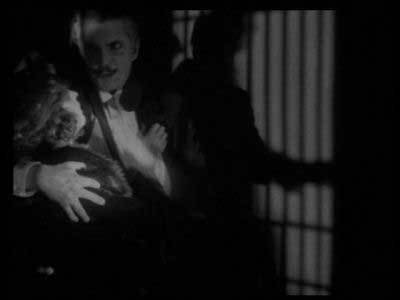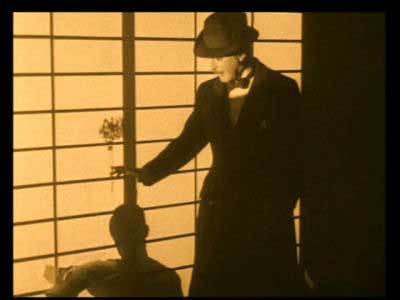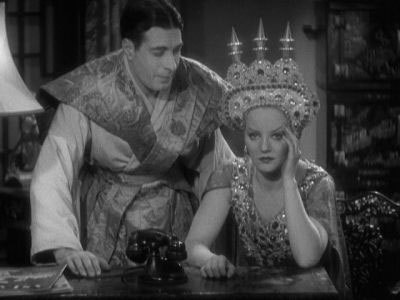A society woman’s plans to make easy money backfire and she turns to a Burmese businessman for help. He agrees to give her the money she needs… for a price. Excellent melodrama that showcased Sessue Hayakawa’s talents to the world. A major smash hit and the film that really put Cecil B. DeMille on the map as a director of premium entertainment.
Home Media Availability: Released on DVD.
Bonus: I will also be reviewing the 1931 pre-code remake starring Tallulah Bankhead. Click here to skip to the talkie reviews.
Chemistry, Box Office, Flesh… Everything Sizzles!
Cecil B. DeMille’s early silent work showed an unerring talent for discovering the lurid fantasies of the audience and exploiting them on the screen, usually to massive box office returns. The Cheat is one of the darkest films of this period in DeMille’s career.
Stage star Fannie Ward was brought to Hollywood to play Edith Hardy, a spoiled socialite who keeps company with Haka Arakau (Sessue Hayakawa), a Burmese ivory trader. Her workaholic husband, Richard (Jack Dean, the real-life Mr. Fannie Ward), is a stock broker on the verge of making the deal of a lifetime.
The deal will mean a fortune but Edith must cut back on her spending so that there will be enough investment capital. Edith refuses. She is the treasurer of the Red Cross and she needs to look her best for events. One cannot possibly help Belgian war orphans in any dress costing less than $500. That translates into over $11,000 in modern money. Some dress!
Edith continues to spend thousands at a clip and “forgets” to pay the staff. But what bothers Richard most of all is her ongoing flirtation with Arakau. Edith wants more money and is tired of Richard scolding her; she decides to earn her own. Richard plays the stock market, why can’t she? The Red Cross has entrusted $10,000 to her safekeeping. She invests the money in a copper stock that is sure to double her investment. Then she will return the money to the Red Cross and no one need ever know. She tells her investment partner that she won the money playing bridge and sits back waiting for wealth to roll in.
Arakau is hosting a Red Cross benefit at his home. He treats Edith to a tour of his private rooms. Arakau has some quirks. He likes to burn his family crest into items that he owns with a branding iron. Any item he owns. He has invited Edith for something more than chitchat but while he is making his move Edith’s investment partner bursts in. The copper stock collapsed, Edith’s money is lost.
Arakau takes in the news with pleasure. He offers to give Edith the missing Red Cross money—for a price. Edith balks but the fear of exposure as an embezzler is too much. She takes Arakau’s check with the understanding that she will pay him back with something other than money. The rendezvous is set for the next night and Edith promises to come.
The next day, though, Richard comes in with news. His stock gamble paid off and they are rich. Edith immediately asks him for $10,000, claiming she lost it playing bridge. What kind of stakes are these socialites playing for? Anyway, Richard writes her a check but is suspicious.
His suspicions are confirmed when Edith sneaks out of the house after dark. Richard follows her to Arakau’s house. Arakau is waiting, in the mood for romance. When Edith offers him the check, he refuses it. The bargain must stand. He blocks Edith’s exit. He plans to make her his, one way or the other. And the branding iron is conveniently red hot…
The Cheat was meant as a vehicle for Fannie Ward. A popular stage star, Ward was forty-four when The Cheat was released. At the time, she was noted for her ageless beauty. The reputation was more propaganda than fact, as The Cheat proves. And, look, I am not in favor of bashing actresses based on their looks but when someone is famous for looking like a maid of sixteen, you kind of notice when they, you know, don’t.
Makeup is expected on an actor but there is a point where it becomes less grease paint and more taxidermy. To the modern viewer, Ward comes off as an attractive matron in some very silly hats looking somewhat younger than she really was but hardly as the delicate ingénue that the script suggests.
Ward also indulges in the grand, sweeping gestures that undid the film careers of so many stage actors. Just after her character has been branded on the shoulder, Ward paces her apartments flailing her arms in misery. Then she is startled and flinches slightly and that brings on a paroxysm of agony.
Fannie, trust us, they can see you in the back.
The delightfully tasteless plot and some admittedly inspired direction by DeMille would be enough to make the viewer overlook to hysterics of Miss Ward but The Cheat has an ace up its sleeve.
Gentle viewers, meet Mr. Sessue Hayakawa.

Hayakawa employed the subtle acting style that would quickly replace the cartoonish movements of the stage. Instead of thrashing gestures and overdone eye rolls that both Fannie Ward and Jack Hardy rely on, Hayakawa commands his scenes with a lifted eyebrow, a slowly spreading smile, a clinch of the jaw, a well-timed glance.
It’s unfortunate that such talent was often wasted as either the villainous Asian or as a sort of Monsieur Butterfly, though Hayakawa did make some excellent Japanese-themed pictures co-starring his wife, Tsuru Aoki. But even in the silliest of roles, Hayakawa managed to keep his dignity and usually out-acted his co-stars.
His talent ensured screen longevity that few of his contemporaries enjoyed. In 1957, Hayakawa received a best supporting actor Academy Award nomination for his role in The Bridge on the River Kwai.
Arakau was originally written as a Japanese character named Tori but the understandably horrified Japanese issued such a strong protest that the character was made Burmese (who apparently had no lobbyists in Hollywood) and renamed. Of course, Hayakawa’s character still dressed in kimonos and surrounded himself with Japanese décor so the titling change was not much of a victory for political correctness.
The Cheat is famous for the branding scene, which is brutal and shockingly realistic, but Hayakawa’s best acting comes at less, shall we say, energetic moments. His calm hatred directed at Edith in the scenes that follow is a model of elegance.
Of all of DeMille’s films, The Cheat is perhaps the most beautifully shot. The photography of Alvin Wyckoff captures silhouettes through windows, suggests whole sets with a few well-placed shadows and makes firelight dance. Most astonishing of all, though, is the sequel to the branding scene. Edith has shot Arakau and he collapses against the paper door. Then there is an exterior shot of the wounded Arakau’s silhouette slowly crumbling to the floor—leaving a smear of blood on the paper.
This is DeMille at his best and most flamboyant. See The Cheat for the cinematography if nothing else.
Where can I see it?
The Cheat is widely available on DVD. The Kino version bundles it with DeMille’s Manslaughter and the Flicker Alley version bundles it with DeMille’s Carmen.
Silents vs. Talkies
The Cheat (1915) vs. The Cheat (1931)
Ladies and gentlemen, in this corner we have Cecil B. DeMille’s lurid race melodrama, The Cheat and in that corner we have Tallulah Bankhead as the cheat herself in the pre-Code 1931 remake.
In the freewheeling world of pre-Code talkies, it was only a matter of time before someone thought to remake The Cheat. And who better to play the out-of-control socialite heroine than Tallulah Bankhead?
Elsa Carlyle is a social butterfly with a gambling addiction, Imelda Marcos-esque wardrobe habits and dubious taste in associates. Her long-suffering husband, Jeffrey (Harvey Stevens) doesn’t object to her extravagance as much as the timing of it. The real bugaboo in his mind is Hardy Livingstone (Irving Pichel), a Great White Hunter-type who has just returned from the mystic East with some distasteful habits. Hardy is fixated on Elsa and follows her every move.
Elsa doesn’t dare ask her husband for money to pay a huge gambling debt and so she borrows money from the Milk Fund and promptly loses it in the stock market. Desperate, she makes a deal with Hardy. But just when it seems that she will lose her honor (or whatever), her husband comes through with the money and Elsa rushes to give Hardy the check. Unfortunately for her, Hardy is not ready to let her off so easily. Branding irons and pistols abound. Remember, this is pre-Code.
Tallulah Bankhead manages to infuse her character with something resembling motivation. Fannie Ward plays Edith as an overgrown spoiled brat; Miss Bankhead plays Elsa as an adrenaline addict. Anything for a thrill, sometimes it works and sometimes it doesn’t but at least she feels alive. While not terribly sympathetic, it comes off as more likable than Edith’s annoying sense of entitlement.
The contrast between Sessue Hayakawa and Irving Pichel is even more marked. Hayakawa’s Arakau is, at first, a handsome and dapper gentleman who is willing lapdog for the overbearing Edith. He reveals the dark facets of his character when he has an opportunity to hold power over her. The emotional evolution is quite natural: from over-eager admiration to a violent rage when he realizes that he has been cheated. It’s easy to see why Edith is on friendly terms with him at the beginning of the film.
The same cannot be said for Hardy Livingstone and Elsa. Rather than suave, Hardy comes off as someone voted most likely to make the sex offender registry. Oozing with menace and lust from the moment he sets his eyes on Elsa, Hardy is enough to give anyone the creeps. No facets, no depth, no character development, just pure villainy.
The talkie’s branding scene is quite staid, with some static silhouettes standing in for the actual actors. DeMille reveled in the sensational nature of the scene. In contrast, remake director George Abbot is both hesitant and reticent about it. He is best remembered today for directing The Pajama Game, about as far away from this film as you can get. The Cheat seems to have stymied him. The only way to handle the sleazy nature of the picture is to jump in with both feet with audacity and panache, two qualities that DeMille possessed in spades.
Both courtroom scenes are over the top, though Tallulah Bankhead adds quite a bit of oomph. A little too much, as it turns out, and she comes as silly in her hysterics.
And the winner is…
THE SILENT
While Tallulah Bankhead adds to the quality of the remake, the combination of DeMille and Hayakawa is unbeatable. Hayakawa’s performance is astonishing in context of the period of film making. In addition to being better directed and featuring a better villain, the 1915 original is better paced with less dead time between the branding scene and the trial.
Of course, both films have the inherent flaw of an unlikable heroine. They both end with the villain being publicly censured for his attack on wifely virtue and the reunited couple living happily ever after. A more satisfying ending would be for Edith/Elsa to go to jail for embezzlement, Arakau/Hardy go to jail for assault and let the long-suffering husband elope with his secretary!
That said, the 1915 version of The Cheat can take its place as one of the masterpieces of early DeMille and one of the best films of the year. The 1931 version is more of a historical curio. It is widely available on DVD.
The Cheat had been remade in 1923 starring Pola Negri. That version is considered lost. A pity.
Sessue Hayakawa reprised his role for a 1937 French remake; that film is presently unavailable in the United States.
Availability: The 1931 version of The Cheat is available as part of the Universal Pre-Code Hollywood box set and as a stand-alone disc.
☙❦❧
Like what you’re reading? Please consider sponsoring me on Patreon. All patrons will get early previews of upcoming features, exclusive polls and other goodies.
Disclosure: Some links included in this post may be affiliate links to products sold by Amazon and as an Amazon Associate I earn from qualifying purchases.









